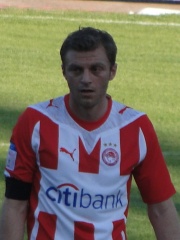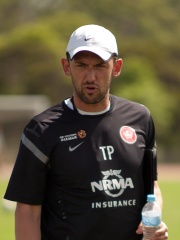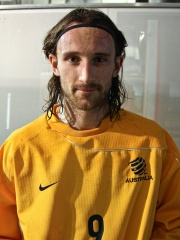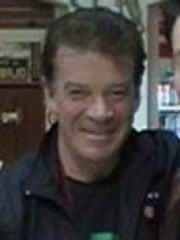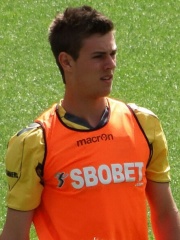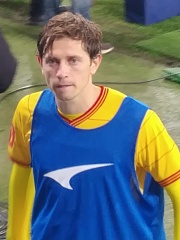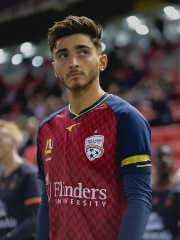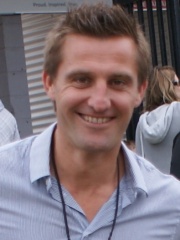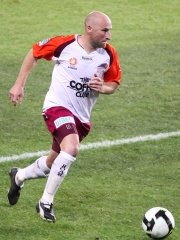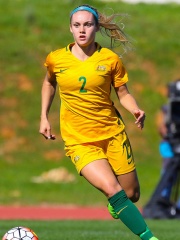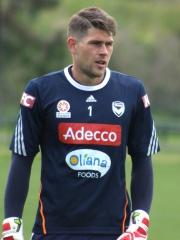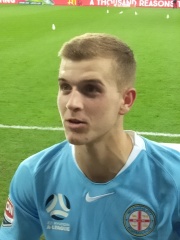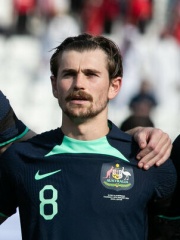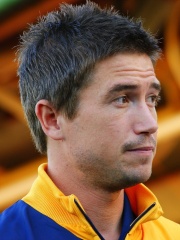
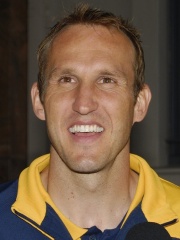
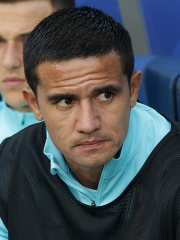
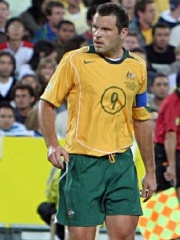
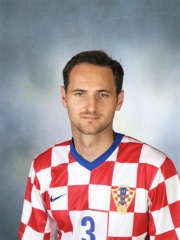
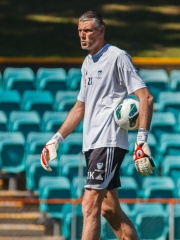
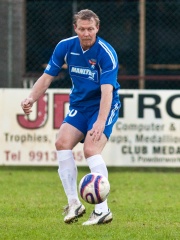
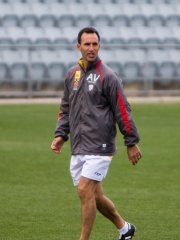
The Most Famous
SOCCER PLAYERS from Australia
This page contains a list of the greatest Australian Soccer Players. The pantheon dataset contains 21,273 Soccer Players, 124 of which were born in Australia. This makes Australia the birth place of the 31st most number of Soccer Players behind South Korea, and Hungary.
Top 10
The following people are considered by Pantheon to be the top 10 most legendary Australian Soccer Players of all time. This list of famous Australian Soccer Players is sorted by HPI (Historical Popularity Index), a metric that aggregates information on a biography’s online popularity. Visit the rankings page to view the entire list of Australian Soccer Players.

1. Harry Kewell (b. 1978)
With an HPI of 48.55, Harry Kewell is the most famous Australian Soccer Player. His biography has been translated into 44 different languages on wikipedia.
Harry Kewell (born 22 September 1978) is an Australian association football coach, manager and former player. He was most recently the manager of Yokohama F. Marinos in the J1 League. As a player, Kewell represented Leeds United, Liverpool, Galatasaray, Melbourne Victory, Al-Gharafa and Melbourne Heart. While at Leeds he was named the PFA Young Player of the Year in 2000. Internationally, he received 58 caps, and scored 17 goals while playing for Australia. A left winger also capable of playing as an attacking midfielder or second striker, he is often regarded within the media as "Australia's finest soccer export", despite his career being blighted with injury. In 2012, Kewell was named Australia's greatest soccer player in a vote by Australian fans, players and media. Kewell scored a goal against Croatia which took Australia through to the knockout stages of the 2006 FIFA World Cup, the Australian national team's second World Cup. He is a member of the Executive Committee of the Australian Professional Footballers' Association. Kewell also has a British passport through his father's heritage. Former Middlesbrough midfielder-turned pundit Robbie Mustoe named Kewell as one of the greatest players he had played against but questioned his consistency and attitude after his initial injuries. Former German international Michael Ballack has also highlighted Kewell's ability and inconsistency. Kewell has represented Australia at the 1995 FIFA U-17 World Championship, the 1997 FIFA Confederations Cup, where Australia finished runners-up, the 2004 OFC Nations Cup, which Australia claimed for the fourth time, the 2006 FIFA World Cup, the 2007 AFC Asian Cup, the 2010 FIFA World Cup and the 2011 AFC Asian Cup, where Australia finished runners-up.

2. Mark Schwarzer (b. 1972)
With an HPI of 46.91, Mark Schwarzer is the 2nd most famous Australian Soccer Player. His biography has been translated into 51 different languages.
Mark Schwarzer (; born 6 October 1972) is an Australian former professional soccer player who played as a goalkeeper. He represented Australia at international level from 1993 to 2013, and was selected for both the 2006 and 2010 FIFA World Cups. Having progressed through the youth ranks of Colo Cougars, Penrith, Blacktown Association and Marconi Stallions, Schwarzer turned professional for National Soccer League side Marconi Stallions in 1990. After making 58 appearances for the club, he moved to German Bundesliga side Dynamo Dresden in 1994, appearing twice, and then to Bundesliga side 1. FC Kaiserslautern in 1995, appearing four times. Schwarzer joined then-second-tier side Bradford City in 1996 and made 16 appearances before joining Premier League club Middlesbrough in February 1997. He made 445 appearances for Middlesbrough, but decided to leave the club in May 2008. He then switched to Premier League side Fulham, and made 218 appearances for the club until he moved to Chelsea in 2013. He was the first – and, to date, only – non-Briton to have made more than 500 Premier League appearances (making him the highest-appearing non-Briton in the Premier League's history), and also the oldest player to have played in the knockout stages of the UEFA Champions League. He joined Leicester City on a free transfer in January 2015 and left the club at the end of their 2015–16 Premier League-winning season. Having played for Australia at under-17 and under-20 level, Schwarzer made his full international debut in a World Cup qualifying match against Canada in 1993 as a substitute after Robert Zabica was sent off in the 17th minute. During the course of his international career, he won a total of 109 caps for his country. He became Australia's most capped male player when he surpassed Alex Tobin's appearance record in January 2011.

3. Tim Cahill (b. 1979)
With an HPI of 46.46, Tim Cahill is the 3rd most famous Australian Soccer Player. His biography has been translated into 61 different languages.
Timothy Filiga Cahill (; born 6 December 1979) is an Australian former professional soccer player who played as an attacking midfielder but also played as a striker on many occasions. A box-to-box midfielder, Cahill became recognised for "his aggressive and powerful approach and his ability to head the ball in the penalty area". Cahill has scored 50 goals in 108 caps between 2004 and 2018 and is regarded as one of the greatest Australian soccer players of all time. He currently works as a pundit for BBC Sport and Sky Sports. In 1997, Cahill left Sydney for England to play professionally; there he was signed by Millwall on a free transfer from Sydney United. He was part of the Millwall side that won the Football League Second Division title in the 2000–01 season, and was also a central part of Millwall's run to the 2004 FA Cup Final. Before the start of the 2004–05 season, Cahill was transferred to Everton. He was named both Everton Player of the Season and Everton Players' Player of the Season in his debut season, and in the following year he was named as one of 50 nominees for the Ballon d'Or, becoming the first Everton player in 11 years to be nominated. He was also part of the Everton side that reached the final of the 2008–09 FA Cup. Since leaving Everton in 2012, Cahill has played for the New York Red Bulls, Shanghai Shenhua, Hangzhou Greentown and Melbourne City. After a brief spell at former club Millwall, he ended his career at Jamshedpur. Cahill was the first Australian to score at a FIFA World Cup, scored in three World Cups (2006, 2010, 2014) and has scored the most goals by any Australian in the men's World Cup with five goals. In 2007, he became the first Australian player to score at an AFC Asian Cup. Cahill is known for his adept heading ability and high vertical leap, having scored many of his goals with his head. He is famous for his regular goal celebration of shadow boxing around the corner flag.

4. Mark Viduka (b. 1975)
With an HPI of 45.26, Mark Viduka is the 4th most famous Australian Soccer Player. His biography has been translated into 45 different languages.
Mark Antony Viduka ( vih-DOOK-ə; born 9 October 1975) is an Australian former soccer player who played as a centre forward. Viduka captained the Australia national team at the 2006 FIFA World Cup, reaching the Round of 16, which remains their joint-best performance to date. His four goals in the UEFA Champions League are the most scored by any Australian player.
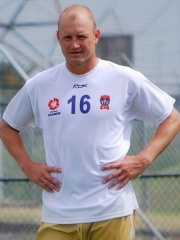
5. Stephen Laybutt (1977 - 2024)
With an HPI of 44.85, Stephen Laybutt is the 5th most famous Australian Soccer Player. His biography has been translated into 45 different languages.
Stephen John Laybutt (3 September 1977 – 13 January 2024) was an Australian professional soccer player who played as a defender. Laybutt came out as gay in 2021 and died by suicide in January 2024.

6. Josip Šimunić (b. 1978)
With an HPI of 44.02, Josip Šimunić is the 6th most famous Australian Soccer Player. His biography has been translated into 38 different languages.
Josip "Joe" Šimunić (Croatian pronunciation: [jǒsip ʃǐmunitɕ]; born 18 February 1978) is a retired footballer and current president of NK Rudeš. Born in Australia to Bosnian Croat parents, Šimunić started his career at Melbourne Knights then moved to Germany where he spent 14 seasons in the Bundesliga with Hamburger SV, Hertha BSC and TSG 1899 Hoffenheim before finishing his career in Croatia with Dinamo Zagreb. He played for Croatia from 2001 to 2013, appeared in five major tournaments for Croatia – 2002 and 2006 World Cups, as well as the 2004, 2008 and 2012 European Championships – and is the sixth most capped player in the history of the Croatia national team.

7. Zeljko Kalac (b. 1972)
With an HPI of 43.64, Zeljko Kalac is the 7th most famous Australian Soccer Player. His biography has been translated into 34 different languages.
Zeljko Kalac (born 16 December 1972) is an Australian former soccer player who is currently manager of Sydney United 58 in the National Premier Leagues NSW. Standing at 2.02 m, Kalac is the tallest player to have represented the Australia national football team. Although he was a goalkeeper, Kalac's preferred playing number (when not the conventional number 1) is 18 and has generally worn this number when playing for Australia. However, when he joined Italian club A.C. Milan in 2005, the number 18 was already claimed by Marek Jankulovski, who joined at the same time, and so he chose number 16. When he transferred to Kavala, number 18 was also taken, so he settled for number 60.

8. Matthew Bingley (b. 1971)
With an HPI of 43.47, Matthew Bingley is the 8th most famous Australian Soccer Player. His biography has been translated into 45 different languages.
Matthew Bingley (born 16 August 1971) is an Australian former soccer player. A utility who can play in midfield or defence, he has played over 300 matches in nearly 20 years at the highest level of domestic football in Australia. Bingley also made 14 appearances for the Australian national team, scoring five goals.

9. Aurelio Vidmar (b. 1967)
With an HPI of 43.15, Aurelio Vidmar is the 9th most famous Australian Soccer Player. His biography has been translated into 46 different languages.
Aurelio Vidmar ( aw-REEL-ee-oh VID-mar; born 3 February 1967) is an Australian association football manager and former player, currently manager of Melbourne City. He is a former captain of the Australia national team and former coach of the Australia U23 national team. In recognition of decorated national team career, and his service to Adelaide United, the southern end of Hindmarsh Stadium is named the Vidmar End.

10. Ned Zelic (b. 1971)
With an HPI of 42.75, Ned Zelic is the 10th most famous Australian Soccer Player. His biography has been translated into 46 different languages.
Nedjeljko Zelic (born 4 July 1971), commonly known as Ned Zelic, is an Australian former footballer who played as a centre-back or defensive midfielder.
People
Pantheon has 160 people classified as Australian soccer players born between 1943 and 2002. Of these 160, 157 (98.13%) of them are still alive today. The most famous living Australian soccer players include Harry Kewell, Mark Schwarzer, and Tim Cahill. The most famous deceased Australian soccer players include Stephen Laybutt, Johnny Warren, and Dylan Tombides. As of April 2024, 37 new Australian soccer players have been added to Pantheon including Craig Goodwin, Josh Cavallo, and Andrew Redmayne.
Living Australian Soccer Players
Go to all RankingsHarry Kewell
1978 - Present
HPI: 48.55
Mark Schwarzer
1972 - Present
HPI: 46.91
Tim Cahill
1979 - Present
HPI: 46.46
Mark Viduka
1975 - Present
HPI: 45.26
Josip Šimunić
1978 - Present
HPI: 44.02
Zeljko Kalac
1972 - Present
HPI: 43.64
Matthew Bingley
1971 - Present
HPI: 43.47
Aurelio Vidmar
1967 - Present
HPI: 43.15
Ned Zelic
1971 - Present
HPI: 42.75
Avraam Papadopoulos
1984 - Present
HPI: 42.02
Tony Popovic
1973 - Present
HPI: 41.85
Joshua Kennedy
1982 - Present
HPI: 41.28
Deceased Australian Soccer Players
Go to all RankingsStephen Laybutt
1977 - 2024
HPI: 44.85
Johnny Warren
1943 - 2004
HPI: 40.59
Dylan Tombides
1994 - 2014
HPI: 21.21
Newly Added Australian Soccer Players (2024)
Go to all RankingsCraig Goodwin
1991 - Present
HPI: 34.31
Josh Cavallo
1999 - Present
HPI: 31.05
Andrew Redmayne
1989 - Present
HPI: 29.05
David Zdrilic
1974 - Present
HPI: 27.90
Jonathan McKain
1982 - Present
HPI: 25.93
Danny Tiatto
1973 - Present
HPI: 25.17
Ellie Carpenter
2000 - Present
HPI: 23.08
Nathan Coe
1982 - Present
HPI: 23.02
Kye Rowles
1998 - Present
HPI: 21.04
Nathaniel Atkinson
1999 - Present
HPI: 21.01
Riley McGree
1998 - Present
HPI: 20.95
Connor Metcalfe
1999 - Present
HPI: 18.86
Overlapping Lives
Which Soccer Players were alive at the same time? This visualization shows the lifespans of the 3 most globally memorable Soccer Players since 1700.

